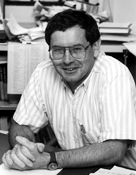NAS Elects New Members
June 15, 1998

Paul Rabinowitz
Two of the other new members have been the recipients of important SIAM prizes---Andrew Yao of Princeton University, who received the George P�lya Prize in 1987, and Paul Rabinowitz of the University of Wisconsin, who received the 1998 George David Birkhoff Prize.
At the Interface Between Analysis and Applications
"Perhaps more than anyone else," wrote the Birkhoff prize committee, "Paul Rabinowitz has deeply influenced the field of nonlinear analysis." His methods have "changed the way we think about" nonlinear systems.
Rabinowitz's global bifurcation theorem, which states that under certain circumstances a local linearized analysis forces the existence of a global bifurcation, was described by the committee as "astonishing for its many applications." "I have always found the interface between analysis and applications to be a fruitful area," said Rabinowitz on receiving the prize in January at the Baltimore meeting of the American Mathematical Society. "The interaction between problems and methods has always been central to my work. . . . The solutions of concrete problems lead to general methods, which in turn lead to progress on broader classes of problems."
The Birkhoff prize, which recognizes outstanding contributions to applied mathematics in the highest and broadest sense, is awarded jointly every five years by AMS and SIAM.
Interested early in his career in PDEs, Rabinowitz now works mainly in dynamical systems. In 1977 he brought another interest, in the calculus of variations, to bear in proving the existence of periodic solutions of Hamiltonian systems in a star-shaped energy surface. Central to mechanics, the existence of periodic orbits is an area to which G.D. Birkhoff made fundamental contributions.
At Wisconsin since 1969, where he was named the E.B. Van Vleck Professor of Mathematics in 1986, Rabinowitz was a Guggenheim Fellow in 1978-79; he was elected to the American Academy of Arts and Sciences in 1987, and he received an honorary degree from the University of Paris in 1992.
Computational Complexity and Algorithm Design
"For 25 years," say his colleagues Avi Wigderson of the Institute for Computer Science, in Jersualem, and Silvio Micali of MIT, "Andy Yao has been producing landmark results in almost every aspect of computational complexity and in many aspects of algorithmic design. His results and proof methods have caused a true leap in our understanding of central issues."

Andrew Yao
In particular, they point to Yao's "fundamental contributions to communication complexity, pseudo-randomness, cryptography, lower bounds for Boolean circuits, and, more recently, to the theory of quantum computation and communication." Yao is the William and Edna Macaleer Professor of Engineering and Applied Science at Princeton. In 1987, he received one of SIAM's highest honors, the George P�lya Prize, then given only every four years, in recognition of outstanding work in combinatorics. Through his "deep work in computational complexity, in particular his work on separating the polynomial-time hierarchy," the prize committee said, Yao provided "one of the most important and impressive contributions to the P = NP questions." From 1989 to 1991, Yao was the editor-in-chief of SIAM Journal on Computing.
Wavelets Revisited
For his pioneering research on wavelet packets, Ronald Coifman received two major awards in 1996: the Defense Advanced Research Projects Agency's Achievement Award for Sustained Excellence by a Contractor and, for his contributions to the state's scientific development, the State of Connecticut Medal of Science. A member of the Yale faculty since 1980, Coifman holds a joint patent with Yale for the discovery.

Ronald Coifman. (Photograph by Michael Marsland, Office of Public Affairs, Yale University.)
Wavelet packets, which have been used by the FBI and Scotland Yard to compress fingerprint files for transmission over telephone lines, also have potential applications in target recognition by smart weapons, characterization of petroleum reservoirs, and improved mammograms and ultrasound images. (The application selected by Cipra for the 1993 SIAM News article was Coifman's use of a technique he calls adapted waveform analysis to clean up an old recording of Brahms playing his First Hungarian Dance on the piano; not even recognizable as music at the beginning, the denoised sound, Cipra reported, was "good enough to give a sense of Brahms's style of play.")
Ingrid Daubechies joined the Princeton faculty in 1994, becoming the mathematics department's first tenured woman. Her well-known contributions to the field of wavelets include her early work showing Haar wavelets to be the first in a family of compactly supported nonsmooth wavelets; this work is widely credited with making wavelets practical.
Daubechies is the author of Ten Lectures on Wavelets, the 1992 book that has become one of SIAM's all-time bestsellers. Based on a series of lectures she gave at a conference sponsored by the Conference Board of the Mathematical Sciences in 1990, the book was well on its way to becoming "a classic text in mathematics and a reference to those seriously using wavelets," according to an early review in the Journal of Electronic Imaging. Science reviewer F. Alberto Grunbaum praised it for its "completely engrossing" presentation; "it is like reading a good, thick Russian novel," he wrote. Not surprisingly, Daubechies attributes her success in large part to her ability to make wavelet technology accessible to those who can apply it.
As the third of Cipra's trio of early users of wavelets, Stanford statistician David Donoho and colleagues had developed a "wavelet shrinkage" technique to clean up noisy data. Beginning with the application of a wavelet transform to a noisy signal or data set, the technique shrinks each wavelet coefficient toward zero and then inverts the altered coefficients to produce a "denoised" signal.
Donoho's work in nonlinear signal recovery and high-dimensional data analysis actually encompasses a wide range of interests, focused, again as reported by Barry Cipra, on two main themes: methods for filling in data that are seemingly lost and "seeing" what is occurring in multivariate data sets.
Foreign Associates
Also widely known in the applied and computational mathematics community are two of the new foreign associates of NAS---Kiyosi It� and Roger Penrose. It� is a professor emeritus of Kyoto University; the It� calculus is the mathematical foundation for the Black-Scholes formula. Penrose, the Rouse Ball Professor of Mathematics at Oxford University, has been featured in recent years in SIAM News as the author of books for a general audience, including The Emperor's New Mind (reviewed by Philip Davis). Like Daubechies, Penrose and It� are the authors of books in SIAM's CBMS series: Techniques of Differential Topology in Relativity (Penrose, 1972) and Foundations of Stochastic Differential Equations in Infinite Dimensional Spaces (It�, 1984).

